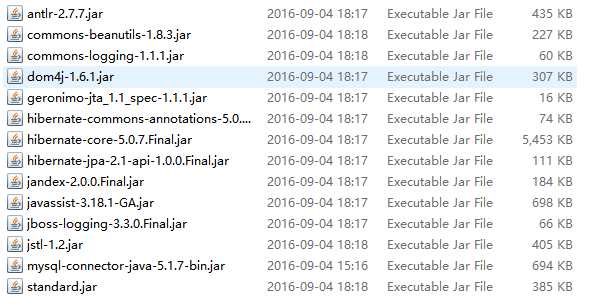一、What is Hibernate?
1、hibernate框架可以理解为一个半成品项目,hibernate就是一个持久层的ORM的框架
ORM -------->对象关系映射(Object Relational Mapping),是对JDBC进行轻量级的对象封装,也就是你可以按照java面向对象思路来操作。
--------> hibernate属于4级:完全面向对象操作数据库、mybatis属于2级、dbutils属于1级(了解)
java持久层框架之一,开源既免费
目的:提高开发效率
2、优势:
- hibernate相对jdbc 访问数据使用的代码轻量化,采用缓存机制减少内存消耗、减小数据访问的压力、加快运行效率
- hibernate基于jdbc 的持久化框架,简化啦对DAO层的编码
- hibernate 性能那就没得说啦,(会在后面的章节详细说明)
- hibernate的可扩展性,别忘记他是开源的当然API也是开放的
二、准备工作
1、导包
2、构建数据库
(可以不写入数据库,hibernate 是可以通过对象映射生成数据库表的
类似于mybatis的逆向工程但是相对的)
3、创建实体包
4、创建配置映射文件
1、编写对象数据源Customer.hbm.xml
<?xml version="1.0" encoding="UTF-8"?> <!DOCTYPE hibernate-mapping PUBLIC "-//Hibernate/Hibernate Mapping DTD 3.0//EN" "http://www.hibernate.org/dtd/hibernate-mapping-3.0.dtd"> <!-- 配置表与实体对象的关系 --> <!-- package属性:填写一个包名.在元素内部凡是需要书写完整类名的属性,可以直接写简答类名了. --> <hibernate-mapping package="cn.itheima.domain" > <!-- class元素: 配置实体与表的对应关系的 name: 完整类名 table:数据库表名 --> <class name="Customer" table="cst_customer" > <!-- id元素:配置主键映射的属性 name: 填写主键对应属性名 column(可选): 填写表中的主键列名.默认值:列名会默认使用属性名 type(可选):填写列(属性)的类型.hibernate会自动检测实体的属性类型. 每个类型有三种填法: java类型|hibernate类型|数据库类型 not-null(可选):配置该属性(列)是否不能为空. 默认值:false length(可选):配置数据库中列的长度. 默认值:使用数据库类型的最大长度 --> <id name="cust_id" > <!-- generator:主键生成策略(明天讲) --> <generator class="native"></generator> </id> <!-- property元素:除id之外的普通属性映射 name: 填写属性名 column(可选): 填写列名 type(可选):填写列(属性)的类型.hibernate会自动检测实体的属性类型. 每个类型有三种填法: java类型|hibernate类型|数据库类型 not-null(可选):配置该属性(列)是否不能为空. 默认值:false length(可选):配置数据库中列的长度. 默认值:使用数据库类型的最大长度 --> <property name="cust_name" column="cust_name" ></property> <property name="cust_source" column="cust_source" ></property> <property name="cust_industry" column="cust_industry" ></property> <property name="cust_level" column="cust_level" ></property> <property name="cust_linkman" column="cust_linkman" ></property> <property name="cust_phone" column="cust_phone" ></property> <property name="cust_mobile" column="cust_mobile" ></property> </class> </hibernate-mapping>
2.hibernate.cfg.xml
<?xml version="1.0" encoding="UTF-8"?> <!DOCTYPE hibernate-configuration PUBLIC "-//Hibernate/Hibernate Configuration DTD 3.0//EN" "http://www.hibernate.org/dtd/hibernate-configuration-3.0.dtd"> <hibernate-configuration> <session-factory> <!--
name属性取值: #hibernate.dialect org.hibernate.dialect.MySQLDialect #hibernate.dialect org.hibernate.dialect.MySQLInnoDBDialect #hibernate.dialect org.hibernate.dialect.MySQLMyISAMDialect #hibernate.connection.driver_class com.mysql.jdbc.Driver #hibernate.connection.url jdbc:mysql:///test #hibernate.connection.username gavin #hibernate.connection.password --> <!-- 数据库驱动 --> <property name="hibernate.connection.driver_class">com.mysql.jdbc.Driver</property> <!-- 数据库url --> <property name="hibernate.connection.url">jdbc:mysql:///hibernate_32</property> <!-- 数据库连接用户名 --> <property name="hibernate.connection.username">root</property> <!-- 数据库连接密码 --> <property name="hibernate.connection.password">root</property> <!-- 数据库方言 不同的数据库中,sql语法略有区别. 指定方言可以让hibernate框架在生成sql语句时.针对数据库的方言生成. sql99标准: DDL 定义语言 库表的增删改查 DCL 控制语言 事务 权限 DML 操纵语言 增删改查 注意: MYSQL在选择方言时,请选择最短的方言. --> <property name="hibernate.dialect">org.hibernate.dialect.MySQLDialect</property> <!-- #hibernate.show_sql true #hibernate.format_sql true --><!-- 将hibernate生成的sql语句打印到控制台 --> <property name="hibernate.show_sql">true</property> <!-- 将hibernate生成的sql语句格式化(语法缩进) --> <property name="hibernate.format_sql">true</property> <!-- ## auto schema export 自动导出表结构. 自动建表 #hibernate.hbm2ddl.auto create 自动建表.每次框架运行都会创建新的表.以前表将会被覆盖,表数据会丢失.(开发环境中测试使用) #hibernate.hbm2ddl.auto create-drop 自动建表.每次框架运行结束都会将所有表删除.(开发环境中测试使用) #hibernate.hbm2ddl.auto update(推荐使用) 自动生成表.如果已经存在不会再生成.如果表有变动.自动更新表(不会删除任何数据). #hibernate.hbm2ddl.auto validate 校验.不自动生成表.每次启动会校验数据库中表是否正确.校验失败. --> <property name="hibernate.hbm2ddl.auto">update</property> <!-- 引入orm元数据 路径书写: 填写src下的路径 --> <mapping resource="cn/itheima/domain/Customer.hbm.xml" /> </session-factory> </hibernate-configuration>
3、Test
//测试Hibernate框架 public class Demo { @Test //保存客户 public void function1(){ Configuration conf_test = new Configuration().configure(); SessionFactory sessionFactory = conf_test.buildSessionFactory(); Session session = sessionFactory.openSession(); Transaction tx = session.beginTransaction(); //---------------------------------------------- Customer c = new Customer(); c.setCust_name("阿里"); session.save(c);//执行保存 //---------------------------------------------- tx.commit();//提交 session.close();//关闭session缓存 sessionFactory.close();//关闭sessionFactory对象 } }
三、参数介绍(API)
1、Configuration(了解)
//Configuration功能: 配置加载类.用于加载主配置,orm元数据加载
public void dome(){
// 创建空构造
Configuration conf_add = new Confguration();
//读取hibernate.cfg.xml
conf_add.configure();
//创建SessionFactory 对象
SessionFactory sf = conf.buildSessionFactory();
}
2、SessionFactory------>session工厂
/* SessionFactory功能: 用于创建操作数据库核心对象session对象的工厂. 创建session对象 注意:1.sessionFactory 负责保存和使用所有配置信息.消耗内存资源非常大. 2.sessionFactory属于线程安全的对象设计. 结论: 保证在web项目中,只创建一个sessionFactory. */ public void fun(){ Configuration conf = new Configuration(); SessionFactory sf = conf.buildSessionFactory(); //打开一个新的session对象 sf.openSession(); //获得一个与线程绑定的session对象 sf.getCurrentSession(); }
3、Session
重点

/* 缺陷: Session 的线程并是安全的,多并发同时操作一个session时会导致类似于幻读 解决:在设计软件架构时因避免多个线程共用一个session 优势(jdbc): 轻量,实例的创建和销毁不消耗过多资源 Session 缓存(hibernate一级缓存): 目的:存放当前工作单元加载的对象 常用方法: save(),update() 和 saveOrUpdate(): delete() createQuery() 和 createSQLQuery:用于操作数据库 create Criteria()条件插询 */
/*
session对象功能: 表达hibernate框架与数据库之间的连接(话).
session类似于JDBC年代的connection对象.
还可以完成对数据/库中数据的增删改查操作session是hibernate操作数据库的核心对象 */ @Test //事务操作 public void fun1(){ //1 创建,调用空参构造 Configuration conf = new Configuration().configure(); //2 根据配置信息,创建 SessionFactory对象 SessionFactory sf = conf.buildSessionFactory(); //3 获得session Session session = sf.openSession(); //4 session获得操作事务的Transaction对象 //获得操作事务的tx对象 //Transaction tx = session.getTransaction(); //开启事务并获得操作事务的tx对象(建议使用) Transaction tx2 = session.beginTransaction(); //---------------------------------------------- //---------------------------------------------- tx2.commit();//提交事务 tx2.rollback();//回滚事务 session.close();//释放资源 sf.close();//释放资源 }
4、 HibernateUtils
public class HibernateUtils { private static SessionFactory sf; static{ //1 创建,调用空参构造 Configuration conf = new Configuration().configure(); //2 根据配置信息,创建 SessionFactory对象 sf = conf.buildSessionFactory(); } //获得session => 获得全新session public static Session openSession(){ //3 获得session Session session = sf.openSession(); return session; } //获得session => 获得与线程绑定的session public static Session getCurrentSession(){ //3 获得session Session session = sf.getCurrentSession(); return session; } public static void main(String[] args) { System.out.println(HibernateUtils.openSession()); } }
